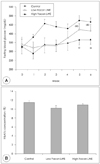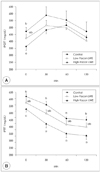Abstract
The aim of this study was to investigate the hypolgycemic activity of water extract of fermented yacon (Smallanthus sonchifolius) leaves tea (Yacon LWE) in high-fat diet (HFD)/streptozotocin (STZ)-induced diabetic mice. Male ICR mice were fed with a HFD (37% calories from fat) for 4 weeks prior to intraperitoneal injection with STZ (100 mg/kg body weight). Diabetic mice were supplemented with two doses of Yacon LWE (0.16% and 0.8%, wt/wt) for 6 weeks. The supplementation of high-dose Yacon LWE significantly lowered blood glucose levels and plasma ALT and AST activities compared with the control group. High-dose Yacon LWE also improved the insulin tolerance without any changes in plasma and pancreatic insulin concentrations in HFD/STZ-induced diabetic mice. Yacon LWE supplementation increased the insulin staining of pancreatic β-cells in a dose-dependent manner. Both 0.16% and 0.8% of Yacon LWE significantly elevated plasma leptin concentration, hepatic glucokinase activity and glucokinase/glucose-6-phosphatase ratio compared with the control group. However, glycosylated hemoglobin concentration was not different among the groups. These results suggest that high-dose Yacon LWE lowers the blood glucose level partly by enhancing insulin sensitivity and hepatic glucose metabolism in type 2 diabetic mice.
Figures and Tables
 | Fig. 1Effect of fermented yacon tea water extract supplementation on fasting blood glucose level (A) and glycosylated hemoglobin concentration (B) in HFD/STZ-induced diabetic mice. Mean ± S.E. (n = 9). Means not sharing a common letter are significantly different among groups by Duncan's multiple range test (p < 0.05). |
 | Fig. 2Effect of fermented yacon tea water extract supplementation on glucose tolerance test (A) and insulin tolerance test (B) in HFD/STZ-induced diabetic mice. Mean ± S.E. (n = 9). Means not sharing a common letter are significantly different among groups by Duncan's multiple range test (p < 0.05). |
 | Fig. 3Effect of fermented yacon tea water extract supplementation on immunohistochemical finding of islet for insulin in HFD/STZ-induced diabetic mice (× 200). |
 | Fig. 4Effect of fermented yacon tea water extract supplementation on plasma aminotransferase activity in HFD/STZ-induced diabetic mice. Mean ± S.E. (n = 9). Means not sharing a common letter are significantly different among groups by Duncan's multiple range test (p < 0.05). |
Table 2
Effect of fermented yacon leaves tea water extract supplementation on body weight, food intake and organ weights in HFD/STZ-induced diabetic mice*

Table 3
Effect of fermented yacon leaves tea water extract supplementation on plasma insulin, C-peptide and leptin concentrations in HFD/STZ-induced diabetic mice*

References
1. Novel V. The lost crops of the Incas. Ceres. 1984. 17:37–40.
2. Ryu JH, Doo HS, Moon JG. Development of cultivation, propagation and manufactured food and new crop, yacon (Polymnia sonchifolia Poepp. & Endl). 1976. Research Report of Ministry of Agriculture & Forestry;26.
3. Goto K. Isolation and structural analysis of oligosaccharides from yacon (Polymnia sonchifolia). Biosci Biotechnol Biochem. 1995. 59:2346–2347.

4. Lee FZ, Lee JC, Yang HC, Jung DS, Eun JB. Chemical composition of dried leaves and stems and crude tubers of yacon (Polymnia sonchifolia). Korean J Food Preserv. 2002. 9:61–66.
5. Lin F, Hasegawa M, Kodama O. Purification and identification of antimicrobial sesquiterpene lactones from yacon (Smallanthus sonchifolius) leaves. Biosci Biotechnol Biochem. 2003. 67:2154–2159.

6. Aybar MJ, Sánchez Riera AN, Grau A, Sánchez SS. Hypoglycemic effect of the water extract of Smallantus sonchifolius (yacon) leaves in normal and diabetic rats. J Ethnopharmacol. 2001. 74:125–132.

7. Valentová K, Cvak L, Muck A, Ulrichova J, Simanek V. Antioxidant activity of extracts from the leaves of Smallanthus sonchifolius. Eur J Nutr. 2003. 42:61–66.

8. Volpato G, Vieira F, Almeida F, Camara F, Lemonica I. II Word Congress on Medicinal and Aromatic Plants for Human Welfare organized by ICMAP-ISHS-SAIPA. 1997. Mendoza, Argentina: 349. Abstract.
9. Miura T, Itoh Y, Ishida T. Hypoglycaemic and hypolipidemic activity of the leaf of Smallanthus sonchifolius in genetically type 2 diabetic mice. J Tradit Med. 2004. 21:275–277.
10. Ogose N, Ai T, Terada S, Yoshioka K, Tago K, Tishimura A, Kajimoto Y, Kajimoto O. The inhibitory effectof the food which consists of the extract from the leaf and stem of yacon on the postprandial increase in blood glucose for subjects with normal blood glucose or borderline diabetes. Japanese Pharmacology & Therapeutics. 2006. 34:737–746.
11. Genta SB, Cabrera WM, Mercado MI, Grau A, Catalán CA, Sánchez SS. Hypoglycemic activity of leaf organic extracts from Smallanthus sonchifolius: Constituents of the most active fractions. Chem Biol Interact. 2010. 185:143–152.

12. American Institute of nutrition. Report of the American Institute of nutrition Ad Hoc committee on standards for nutritional studies. J Nutr. 1977. 107:1340–1348.
13. Hulcher FH, Oleson WH. Simplified spectrophotometric assay for microsomal 3-hydroxy-3-methylglutaryl CoA reductase by measurement of coenzyme A. J Lipid Res. 1973. 14:625–631.

14. Bradford MM. A rapid and sensitive method for the quantitation of microgram quantities of protein utilizing the principle of protein-dye binding. Anal Biochem. 1976. 72:248–254.

15. Davidson AL, Arion WJ. Factors underlying significant underestimations of glucokinase activity in crude liver extract: physiological implications of higher cellular activity. Arch Biochem Biophys. 1987. 253:156–167.

16. Newgard CB, Hirsch LJ, Foster DW, McGarry DJ. Studies on the mechanism by which exogenous glucose is converted into liver glycogen in the rat. J Biol Chem. 1983. 258:8046–8052.

17. Alegre M, Ciudad CJ, Fillat C, Guinovart JJ. Determination of glucose-6-phosphatase activity using the glucose dehydrogenase-coupled reaction. Anal Biochem. 1988. 173:185–189.

18. Bentle LA, Lardy HA. Interaction of anions and divalent metal ions with phosphoenolpyruvate carboxykinase. J Biol Chem. 1976. 251:2916–2921.

19. Chalkley SM, Hettiarachchi M, Chisholm DJ, Kraegen EW. Long-term high-fat feeding leads to severe insulin resistance but not diabetes in Wistar rats. Am J Physiol Endocrinol Metab. 2002. 282:E1231–E1238.
20. Mu J, Woods J, Zhou YP, Roy RS, Li Z, Zycband E, Feng Y, Zhu L, Li C, Howard AD, Moller DE, Thornberry NA, Zhang BB. Chronic inhibition of dipeptidyl peptidase-4 with a sitagliptin analog preserves pancreatic beta-cell mass and function in a rodent model of type 2 diabetes. Diabetes. 2006. 55:1695–1704.

21. Srinivasan K, Viswanad B, Asrat L, Kaul CL, Ramarao P. Combination of high-fat diet-fed and low-dose streptozotocin-treated rat: a model for type 2 diabetes and pharmacological screening. Pharmacol Res. 2005. 52:313–320.

22. Halaas JL, Gajiwala KS, Maffei M, Cohen SL, Chait BT, Rabinowitz D, Lallone RL, Burley SK, Friedman JM. Weight-reducing effects of the plasma protein encoded by the obese gene. Science. 1995. 269:543–546.

23. Friedman JM, Halaas JL. Leptin and the regulation of body weight in mammals. Nature. 1998. 395:763–770.

24. Muzzin P, Eisensmith RC, Copeland KC, Woo SL. Correction of obesity and diabetes in genetically obese mice by leptin gene therapy. Proc Natl Acad Sci USA. 1996. 93:14804–14808.

25. Montague CT, Farooqi IS, Whitehead JP, Soos MA, Rau H, Wareham NJ, Sewter CP, Digby JE, Mohammed SN, Hurst JA, Cheetham CH, Earley AR, Barnett AH, Prins JB, O'Rahilly S. Congenital leptin deficiency is associated with severe early-onset obesity in humans. Nature. 1997. 387:903–908.

26. Licinio J, Caglayan S, Ozata M, Yildiz BO, de Miranda PB, O'Kirwan F, Whitby R, Liang L, Cohen P, Bhasin S, Krauss RM, Veldhuis JD, Wagner AJ, DePaoli AM, McCann SM, Wong ML. Phenotypic effects of leptin replacement on morbid obesity, diabetes mellitus, hypogonadism, and behavior in leptin-deficient adults. Proc Natl Acad Sci USA. 2004. 101:4531–4536.

27. Kusakabe T, Tanioka H, Ebihara K, Hirata M, Miyamoto L, Miyanaga F, Hige H, Aotani D, Fujisawa T, Masuzaki H, Hosoda K, Nakao K. Beneficial effects of leptin on glycaemic and lipid control in a mouse model of type 2 diabetes with increased adiposity induced by streptozotocin and a high-fat diet. Diabetologia. 2009. 52:675–683.

28. Valentová K, Truong NT, Moncion A, de Waziers I, Ulrichová J. Induction of glucokinase mRNA by dietary phenolic compounds in rat liver cells in vitro. J Agric Food Chem. 2007. 55:7726–7731.

29. Jirovský D, Horáková D, Kotouek M, Valentová K, Ulrichová J. Analysis of phenolic acids in plant materials using HPLC with amperometric detection at a platinum tubular electrode. J Sep Sci. 2003. 26:739–742.





 PDF
PDF ePub
ePub Citation
Citation Print
Print




 XML Download
XML Download